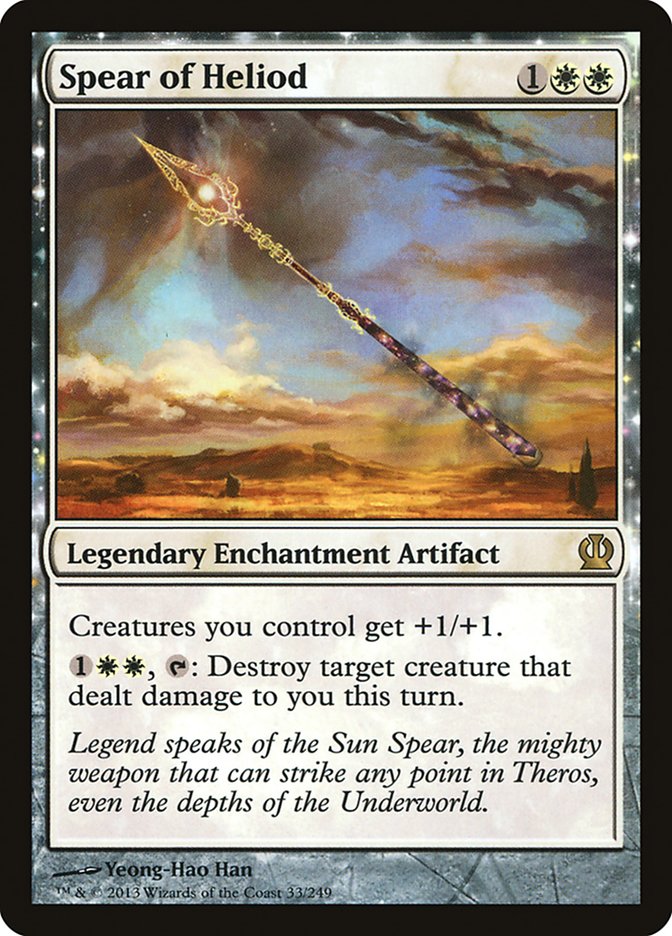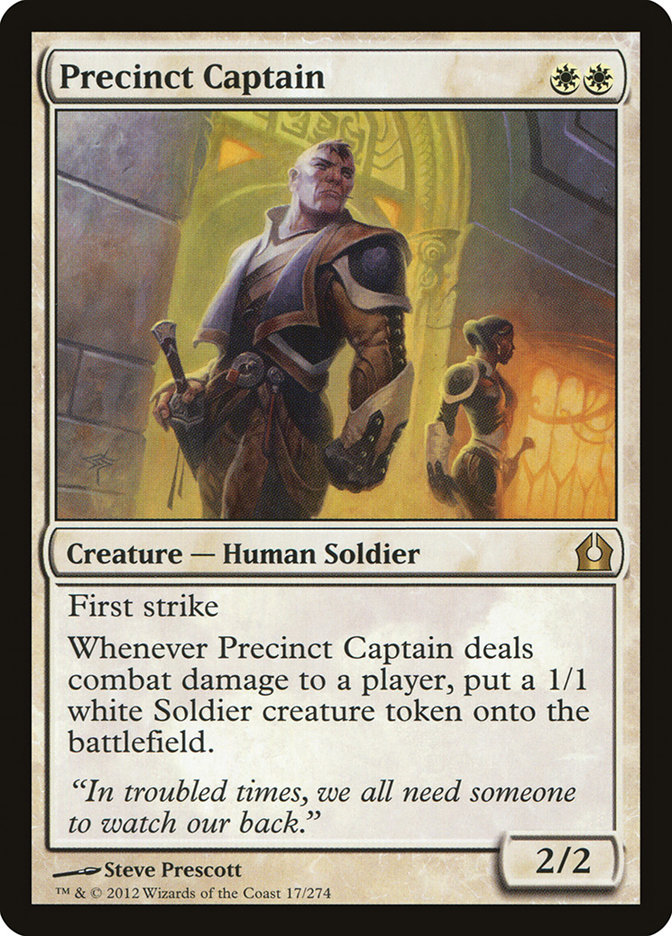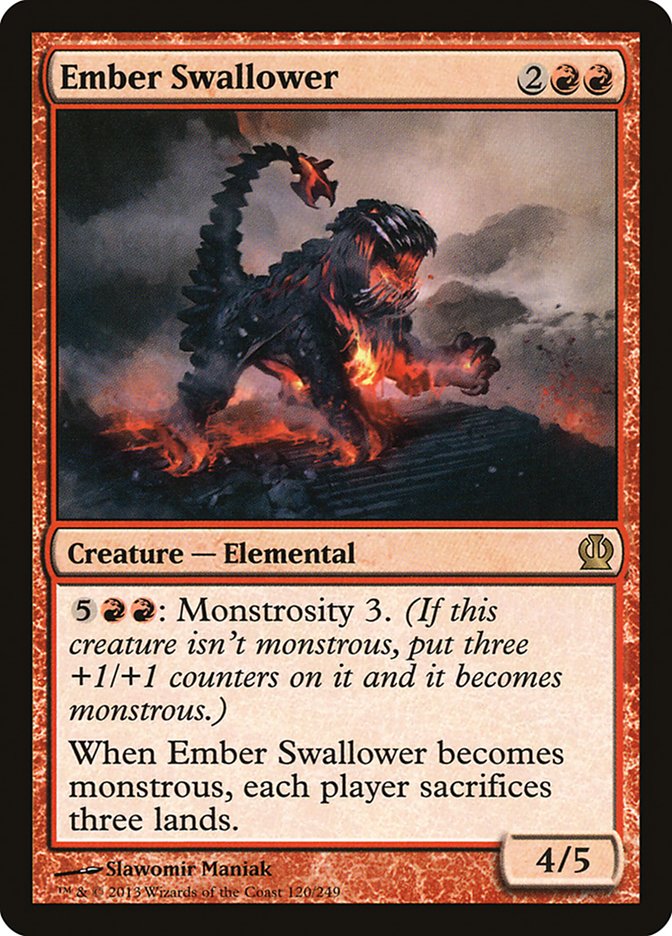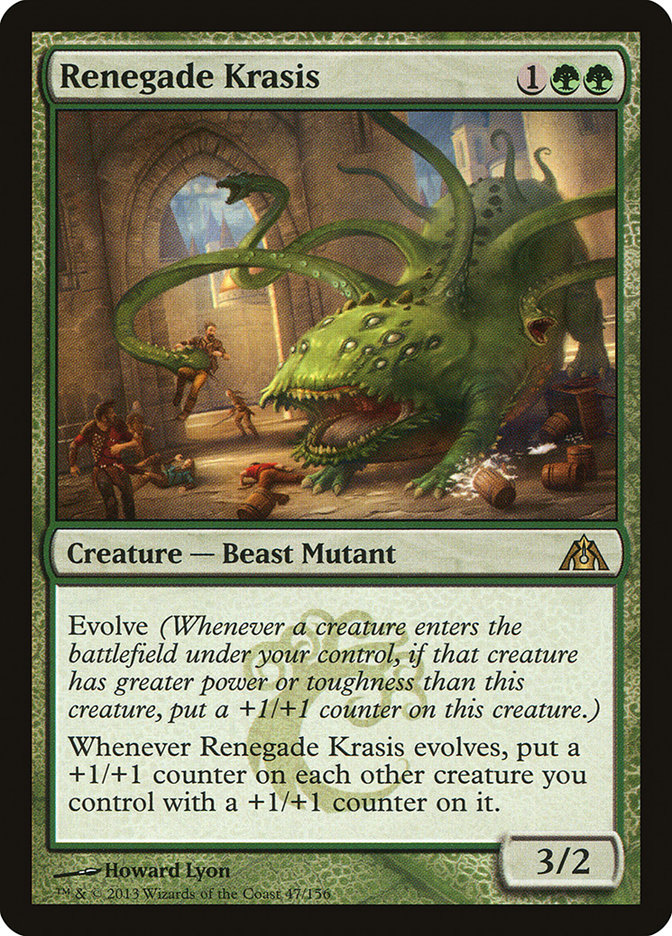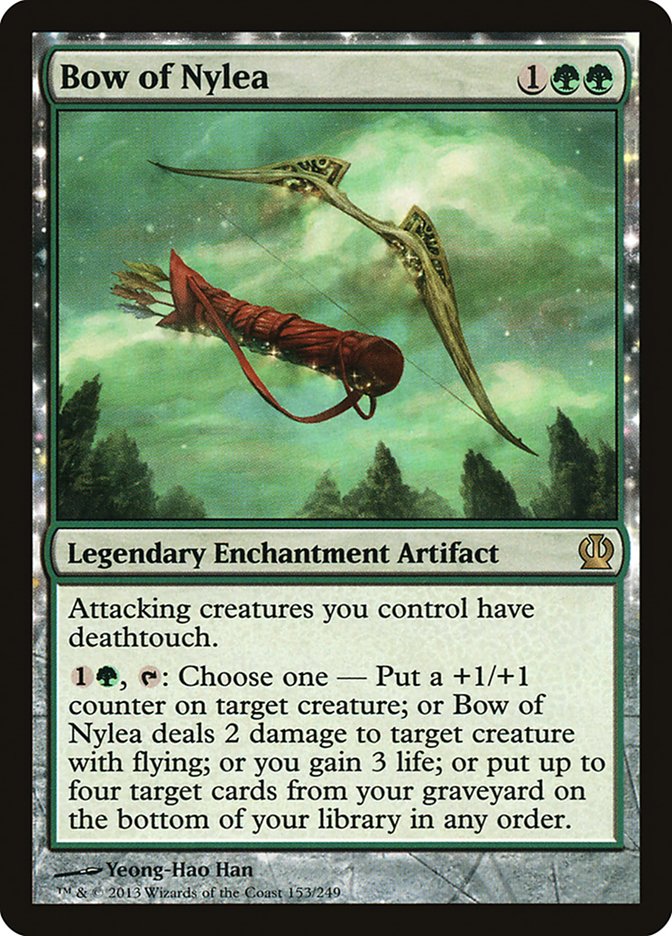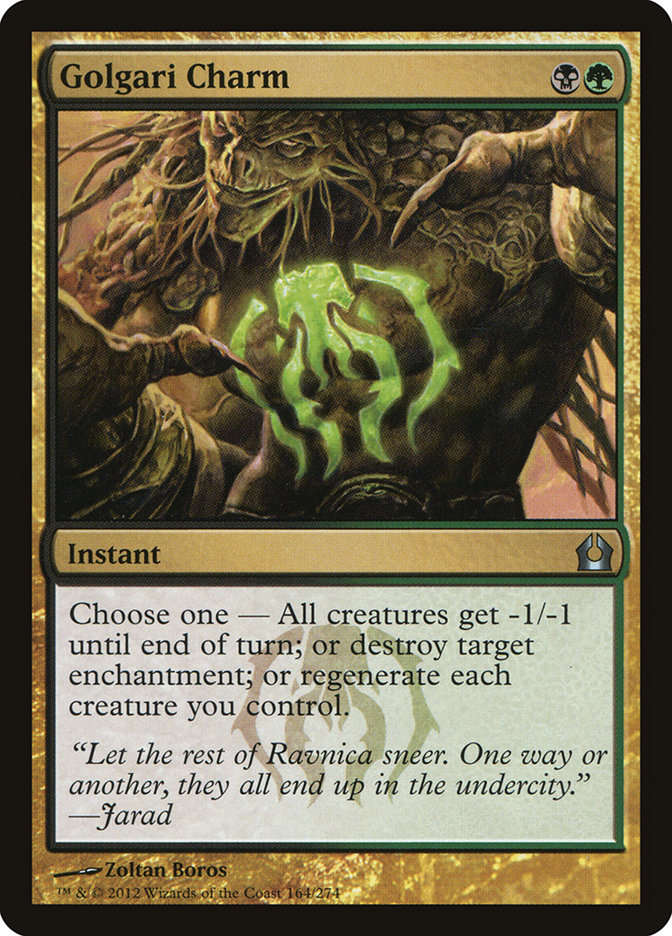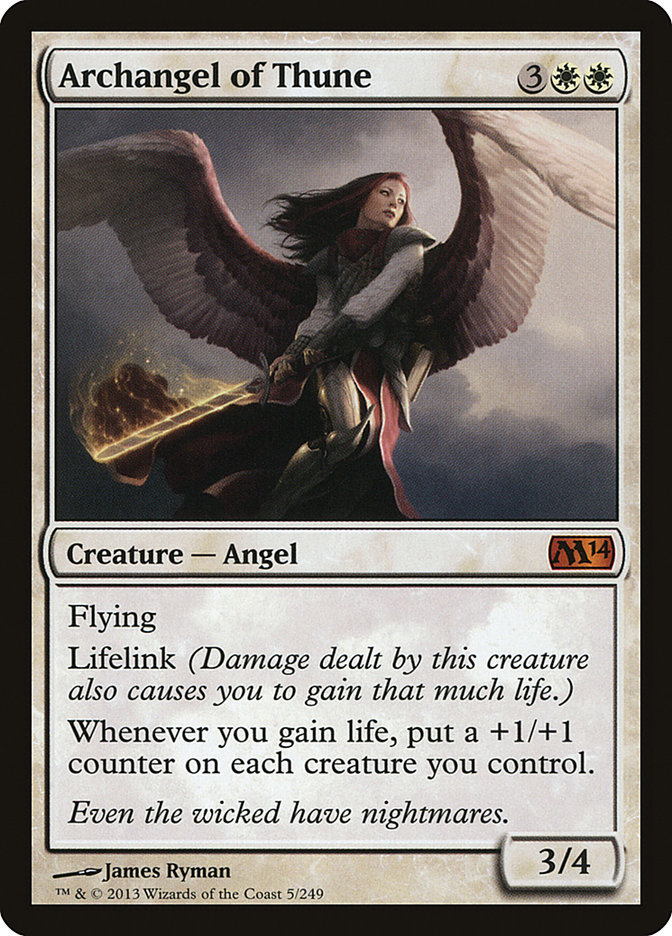As of right now, 138 cards from Theros have been spoiled. Many of the missing cards are the enablers of the set’s mechanics, but for the most part, we have enough tools to start looking at what the Standard format is going to look like.
WE HAVE AN ENEMY!
Creatures (36)
Spells (24)
Sideboard

The whole spoiler isn’t here just yet, but I would be shocked if any other “turn ’em and burn ’em” style cards come crashing into Standard. I think we have our fill and our hands full with this deck.
So this is the ground floor for Standard. Will this be the best deck in the format? Of course it won’t. Will people think that it is the best deck until we have a real metagame? Yup!
Mono-Red Aggro always has a huge target on its head as the must-beat deck of every new Standard format. It’s fast, efficient, and difficult to be a wrong choice right out of the gates since it’s so aggressive. It also doesn’t take a KGB bankroll to invest in, which is a perk in and of itself. This is important because the SCG Open Series starts on release weekend, making it ever so important to get the new cards.
Don’t be fooled into thinking you can ignore it! This deck will put you into the ground faster than Walter White burying his millions. [Editor’s Note: +1] The worst thing you can do is not respect aggro decks. Being good at this game doesn’t mean the tools to beat Legion Loyalist just magically show up on the top of your deck. You have to respect this deck and come prepared.
Even though this isn’t the most powerful Mono-Red Aggro deck that has ever been in Standard doesn’t mean it won’t have a major impact on how we can and cannot build other decks. The most oppressive rule to come from this is no playing three-color decks.
Keep It Simple
You always need a reason to play more colors in Standard. Last season it was easy since decks with three colors almost had more consistent mana bases than most of the two-color decks. The only sacrifice was a couple shocks here and there. It’s a whole different story now.
The mana fixing is horrendous in Theros Standard. Our choices are shock lands, Guildgates, and Temples. There is no Farseek, Borderland Ranger, or even Terramorphic Expanse. Sylvan Caryatid is close to a replacement for Farseek but is still more vulnerable than a land. I do think it will probably be better for what Standard will become, but for now, I’m making a point!
Shock lands, Guildgates, and Temples are much different than what we have become accustomed to. These lands combo very well for a slow midrange-based metagame. They don’t do well against hyperaggressive strategies since half the lands come into play tapped and the others deal damage when they don’t. The more Guildgates and Temples you run, the higher the percentage that every shock land you play deals two damage to you. The more basics you run, the more inconsistent your deck is. In a world as fast as Standard, you can’t afford too much inconsistency.
You only play more colors when it will make your deck better against the field. As of right now, my thought is that three-color mana bases will be so slow that they will almost always make a deck worse even if they are able to have access to things they can’t without the extra color(s).
Three-color decks, get outta here!
What If God Was One Of Us
The flashiest cycle in Theros is the Gods. These “creatures” seem rather powerful on paper and have the added bonus of being mana sinks. This makes them extremely powerful when everything is going well while also having some utility when flooding out. I’m a big fan of this cycle.
The problem is I really don’t know what to do with them. I mean, sure, you can put them in aggressive monocolored decks; we all know that. I just feel that with static and activated abilities these creatures could be powerful in a wider variety of decks.
Creatures (29)
- 4 Dryad Militant
- 4 Precinct Captain
- 4 Boros Elite
- 4 Frontline Medic
- 4 Banisher Priest
- 3 Imposing Sovereign
- 2 Heliod, God of the Sun
- 4 Soldier of the Pantheon
Lands (4)
Spells (27)

Even though Craig Wescoe tried his hardest, Mono-White Humans hasn’t really had its day in the sun yet. I think things are going to change with the inclusion of Spear of Heliod. Now Mono-White Humans not only has a Glorious Anthem but also Brave the Elements. This duo is perfect for a deck filled with tiny and vulnerable creatures.
Precinct Captain is going to do a lot of work in this deck. Not only does it brick wall Mono Red Aggro’s entire team, but it can get very aggressive in the early turns to help create a board presence. Backed up with Spear of Heliod, this stream of Soldiers is almost a guarantee since there are very few creatures that can get bigger than a 3/3 first strike creature on turn 3.
After sideboard, the matchups that do put too many big creatures in the way will have to find an answer to Cavalry Pegasus. This card looks weak on paper but plays out exceptionally well in a matchup with little removal. I predict many Loxodon Smiters having to watch as their masters get pummeled to death by this creature that can magically carry every Human over the battlefield.
Creatures (25)
- 4 Chandra's Phoenix
- 3 Ash Zealot
- 4 Frostburn Weird
- 4 Boros Reckoner
- 4 Ember Swallower
- 3 Purphoros, God of the Forge
- 3 Stormbreath Dragon
Lands (3)
Spells (32)

This is not your normal mono-red deck. Instead of playing twelve one-drops and trying to beat face, this deck tries to win in the midgame with cards like Ember Swallower and Stormbreath Dragon.
I’m a rather big fan of Ember Swallower. This card not only packs a punch against other midrange/control decks but has a perfect body for playing defense. Being able to dodge Selesnya Charm and Mizzium Mortars is no accident. Wizards did this on purpose, and I feel that this card will be that much more powerful because of it.
I want you to ignore the burn package. That can be fixed later once we have a better idea of what the rest of the metagame will look like. The important thing to take away from this decklist is how powerful Nykthos, Shrine to Nyx can be in the right deck. Consider the following:
Turn 2: Magma Jet.
Turn 3: Boros Reckoner.
Turn 4: Ember Swallower.
Turn 5: Activate Nykthos, Shrine to Nyx and you have seven mana to activate Ember Swallower’s ability.
Creatures (35)
- 2 Scavenging Ooze
- 4 Corpsejack Menace
- 2 Lotleth Troll
- 4 Experiment One
- 4 Gyre Sage
- 2 Varolz, the Scar-Striped
- 4 Renegade Krasis
- 4 Elvish Mystic
- 4 Kalonian Hydra
- 2 Nylea, God of the Hunt
- 3 Sylvan Caryatid
Lands (14)
Spells (11)

Renegade Krasis has always been on my watch list, but it never seemed strong enough given how midrange the last metagame was. It’s finally time to give it a chance since there are so many other cards it works well with.
One of the strongest things about this deck is how big Kalonian Hydra can get the instant it hits play. With Renegade Krasis, it becomes a 5/5 the turn you play it. This helps fight off Mizzium Mortars and other midrange-sized creatures. With Corpsejack Menace, it comes into play as an 8/8. If your opponent doesn’t deal with either threat, it will become a staggering 24/24 upon attacking. Now that is some power!
It might be wrong to give a God another God’s weapon, but I don’t think Nylea even likes her Bow. The reason for this blasphemy is that lifelink is one of the best ways for an evolve deck to interact with an opponent. Removal is a little difficult to play in a deck that relies on multiple creatures helping each other out. Every noncreature you draw weakens the power level of the ones you do. This creates a tension when building a deck like this.
Just like the removal in the Big Red deck, the two-drops are very scattered at the moment. These are just all of the ones that I want to play with. The numbers will undoubtedly change once I get some time to test the strategy out, but for now, I want a little bit of everything. This strategy isn’t even that bad when working with evolve creatures. It’s nice to draw one of every card as opposed to multiples since they don’t work well with identical copies of themselves.
Nylea, God of the Hunt might be needed in this deck, but I am concerned with a deck like this getting brick walled by cards like Elspeth, Sun’s Champion and Assemble the Legion. There aren’t enough creatures in this deck with trample, so I want access to a way to get them all through.
One card I want to shine the spotlight on is Golgari Charm. I have a lot of faith in this card being extremely essential for Golgari-based strategies. Now more than ever there is a plethora of one-toughness creatures roaming the battlefield. This card will not only help kill Mono-White Humans’ creature base but also take out pesky Spear of Heliods that find their way to the battlefield. Not only does this card anthem an opponent’s army, but it helps deal with your creatures as well. Who knew Dominarian scientists would put so much effort into advancing the technology of spears after the Thragtusk onslaught of 2012/13?
YES, I KNOW THAT JOKE WAS BAD! [Editor’s Note: It took every inch of my being not to delete it.]
Golgari Charm will also help against U/W-based control decks. Supreme Verdict is and forever will be the bane of an evolve deck’s existence. Golgari Charm backed up by some card advantage is the best way for a deck this linear to fight mass removal. The added bonus is that many control decks will gravitate towards Elspeth, Sun’s Champion as a way to help stem the bleeding, allowing for the -1/-1 ability to absolutely blow them out.
Last but not least, I will take a lesson out of the book of things I learned from Kibler. This is an enchantment-based set. This means that there is a good chance that there will be cards being played that we don’t normally think of. It’s just a smart idea to have answers to these cards even though we don’t know what they are yet.
The Truth
Last but definitely not least is Selesnya. If there were a tournament tomorrow, I would play this deck. I have no clue how the last hundred cards are going to shake things up, but I am dead set on working on this deck for some time.
Creatures (25)
- 3 Loxodon Smiter
- 2 Trostani, Selesnya's Voice
- 2 Angel of Serenity
- 4 Voice of Resurgence
- 4 Elvish Mystic
- 3 Archangel of Thune
- 3 Sylvan Caryatid
- 4 Fleecemane Lion
Planeswalkers (2)
Lands (9)
Spells (24)

Last week I wrote about how I tend to gravitate towards tapout control when a format is brand new. Today I can safely say that I am over it. The mana is just too bad to justify three-color decks, and I don’t think there’s a two-color deck better than this one. It has an aggressive curve that can punish decks that stumble while also having a big mid-to-late game.
One of the best reasons to play a deck like this is that there will be very few midrange strategies right off the bat. There will be dedicated control decks with a ton of removal and hyperaggressive decks. Decks like Selesnya have a tough time against the other midrange decks, so this is perfect.
The entire goal of this deck is to get on the board right away. The deck runs tons of early-game creatures that either accelerate into bigger monsters or can hold the fort immediately. This helps the deck have good curves even though it runs so many late-game spells.
One major advantage of this deck is that it gets to utilize Selesnya Charm. Gods are going to be a big issue moving forward, and Selesnya Charm is one of the very few ways to deal with them. It can also be a nice combat trick.
Angel of Serenity also deals with Gods, making them not much of a concern, but that is not the major reason this creature is in the deck. The reason I like tapout control for early Standard is that it goes over the top of the other strategies. So does this deck. It has an aggressive curve, but at the same time, it has the tools needed to break up board stales and punish decks with very little resistance to attrition.
One of the more elegant things about this deck is the interaction between Archangel of Thune and Elspeth, Sun’s Champion. These two cards get to curve out together on a perfect day, and when this happens there are two really interesting lines you can take. If there are a ton of high-power creatures on your opponent’s board, you can tick Elspeth down, destroying them before you attack and making Archangel of Thune a 4/5. If there isn’t much of a resistance, you can make three 1/1 Soldiers before triggering the Angel’s ability.
I don’t even mind playing against control-based strategies with this deck. Fleecemane Lion is a serious threat for decks like U/W and something they will almost always have to try to deal with before turn 5. This is a unique type of pressure you get to put on an opponent in the early game. Sometimes they will be forced to cast Supreme Verdict even if you spent most of your time playing cards like Spear of Heliod or even the God itself. You even can hold up for Advent of the Wurm the turn before you get to five mana, making it very difficult for a control deck to make a profitable play.
That’s all I have for this week. Next week we will have the entire spoiler, so I will finally be able to go really in depth with how Standard is going to shape up, but for now, I hope I was some help in deciding what direction you want to go when Theros comes knocking at your door. I will see you guys next week!

